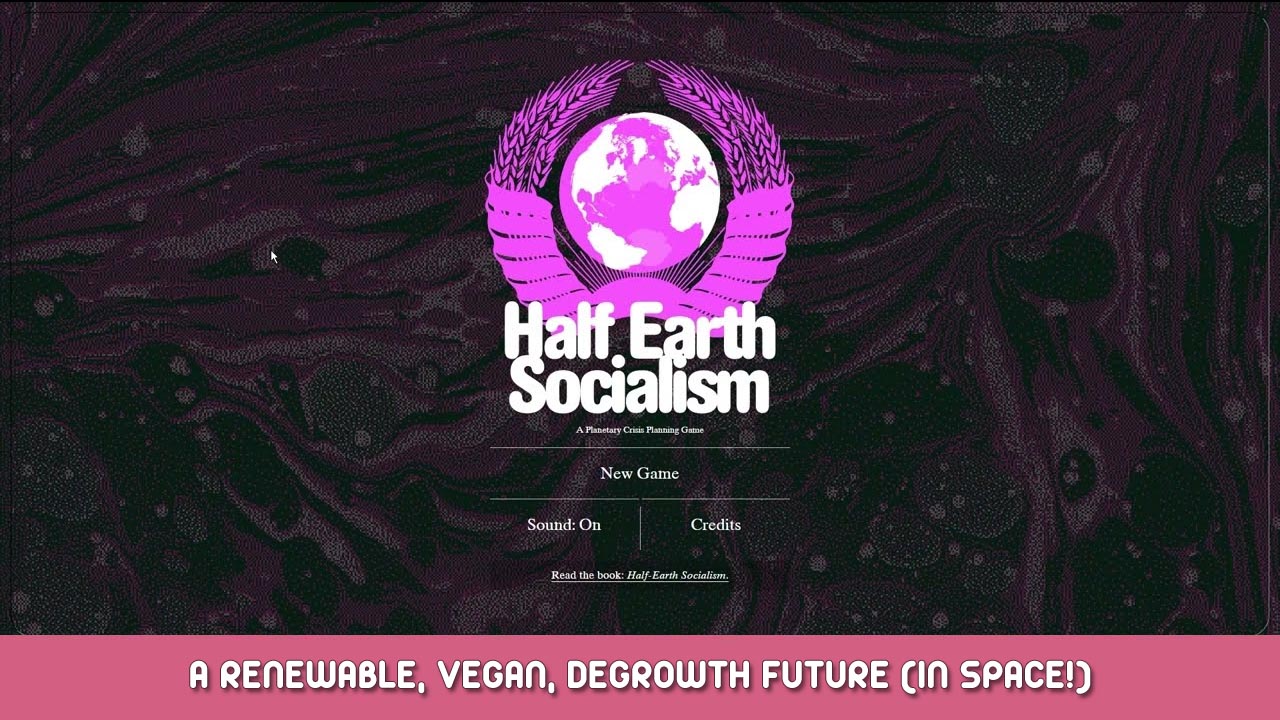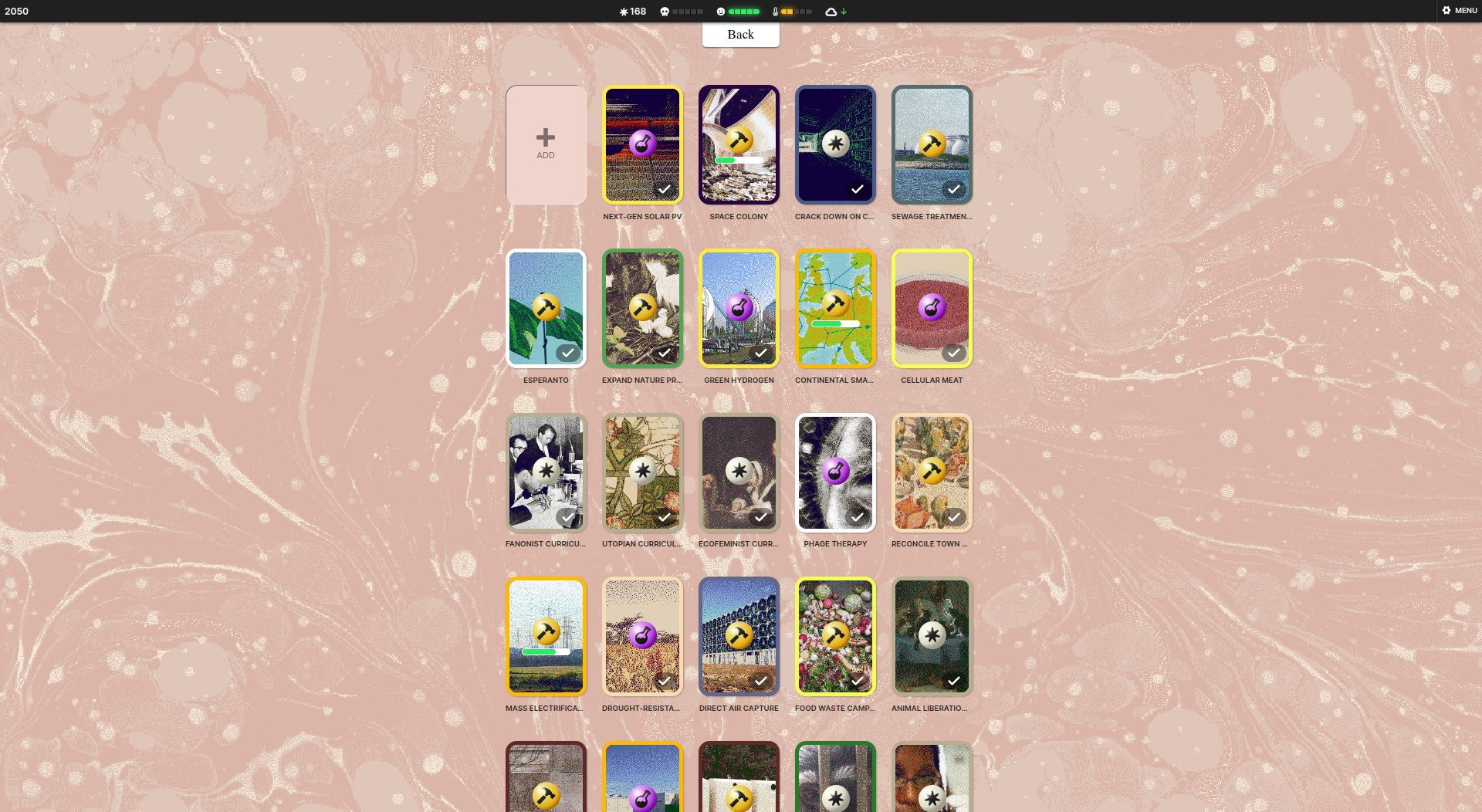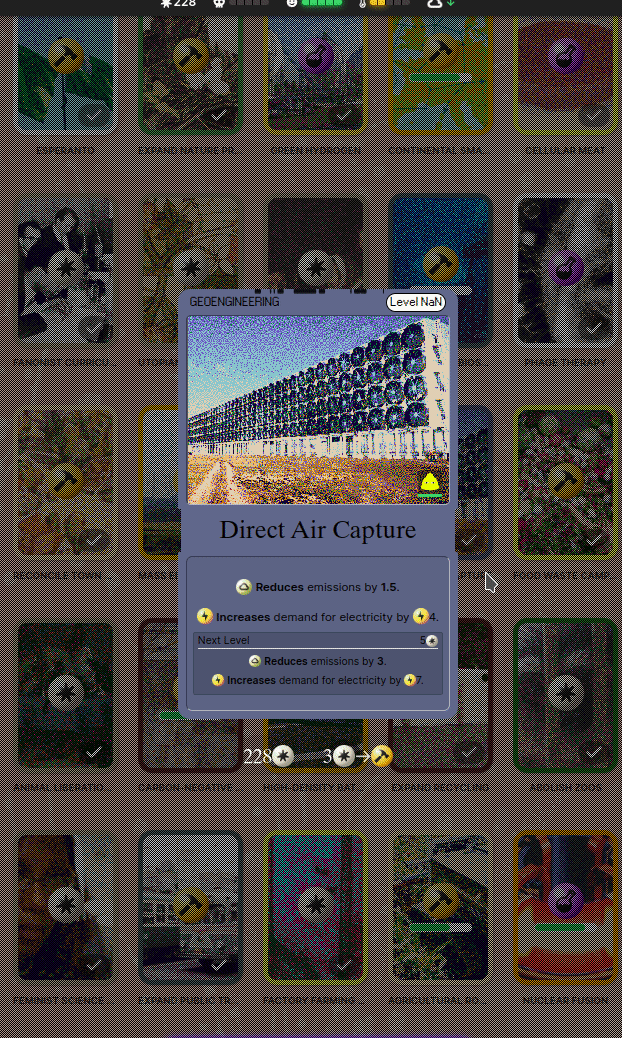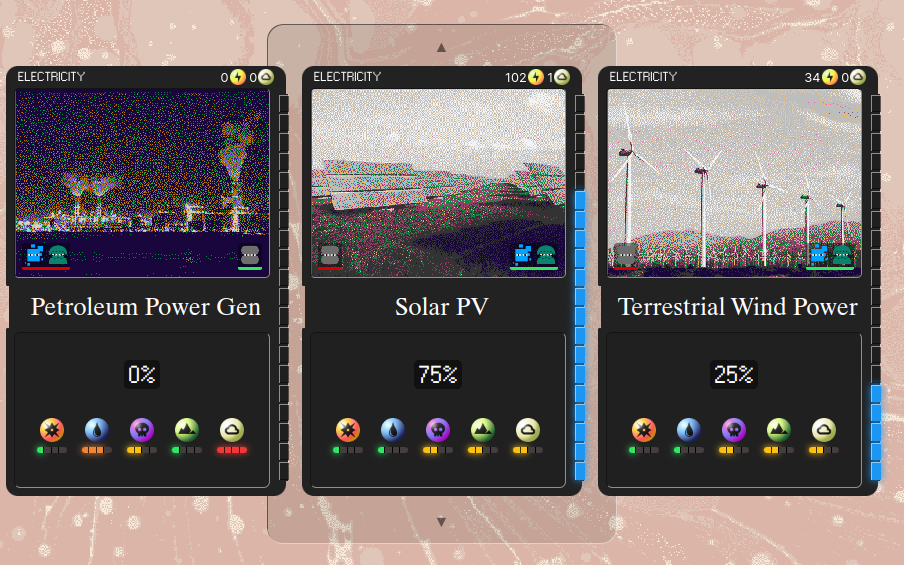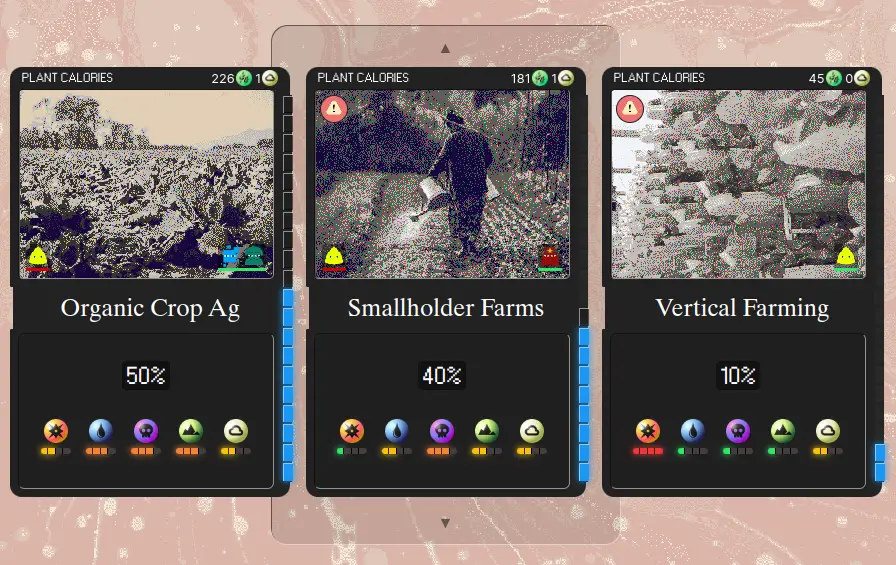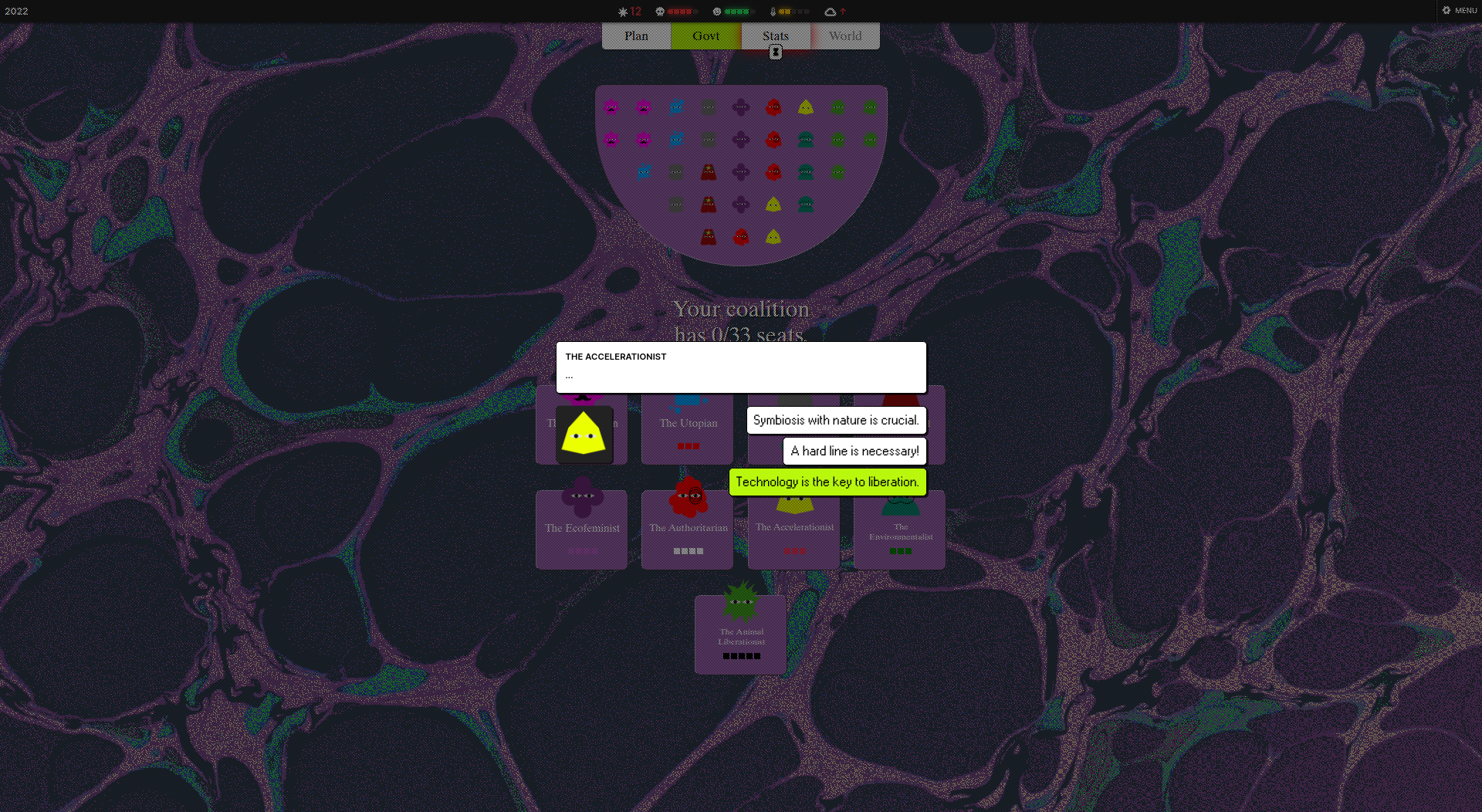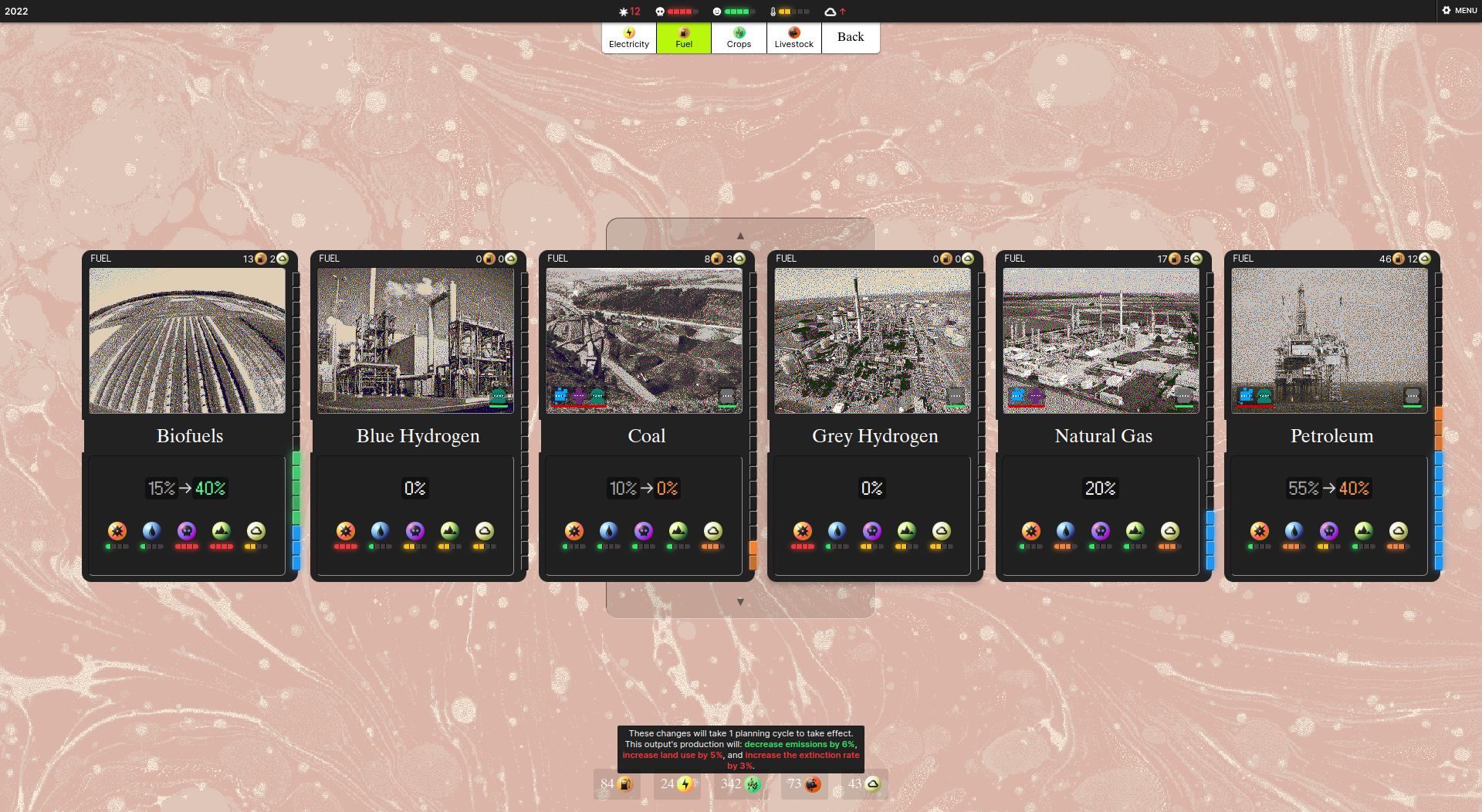A guide for reliably completing the game (and going to space), using the book it’s based on as a starting point. Includes general rules to follow and an example playthrough.
Introduction
Hello!
This guide is by no means the only way to beat the game, but it’s been the most reliable in my experience (and pushes humanity to the stars as a bonus). If you’re having trouble completing it on your own, this is the guide for you!
By the end of the game, you should have:
First, I’ll outline what I see as the general principles that I followed, before diving into a more detailed example of one of my playthroughs, planning session by planning session.
General Guidelines
The guidelines that’ll reliably put you on the right track to planetary wellbeing come from the main arguments of the Book that this game is based off of, namely:
- Rewilding half the earth to absorb carbon emissions and restore biodiversity
- A rapid transition to renewable energy, paired with drastic cuts in consumption by the world’s wealthiest
- Global veganism to cut down on energy and land use
And of course, worldwide socialist planning to efficiently and equitably manage production (but that’s assumed from the outset by the premise of the game).
To do this democratically, the book argues a broad coalition of
Eco-feminists,
Environmentalists,
Animal Liberationists,
Fanonistsand
Utopian Socialistsis needed. You’ll find that most of the policies these factions favour will generally be the most impactful for achieving the goals above.
Many of the cards I implement hew closely to this, with the addition of a bonus stretch goal of establishing an off-world colony and space elevator in the process. If you follow the above principles, you’ll succeed pretty easily even without a more specific guide.
Essential Cards
If you want to cut consumption…You’ll want to implement the Energy Quotas and Degrowth in Developed Regions policy cards. The former is unlocked by building the Battery Storage Network card, while the latter is unlocked by having the Fanonist as an ally.
The Rien Faire Comme une Bête policy card can also be very useful here too – while it does mean that projects will take a slower time to complete, this isn’t actually too much of a problem in practice.
If you want to reduce animal consumption…You’ll want the Vegetarian/Vegan Mandate policy cards. These can be unlocked through implementing the Flexitarian or Meatless Monday policy cards (which can be unlocked through the Environmentalist Curriculum and Animal Liberationist Curriculum policy cards respectively) or researching Cellular Meat.
If you want to send humanity to the stars…You’ll want to build the Space Colony and Space Elevator projects. The Search for Extraterrestrial Life research card unlocks these two items, but you can unlock the latter quicker by implementing the Accelerationist Curriculum policy card (which is recommended due to Space Elevator’s long build time).
If you want to electrify the world…You’ll want to build the Mass Electrification project. This is unlocked by building the Continental Smart Grid card (which can be unlocked by researching the High-Density Batteries card). Its construction can be sped up by building the Battery Storage Network card first.
Withdrawing/Re-implementing Cards
Something that the game doesn’t explicitly outline is that you can access, withdraw and even re-implement any of the previous cards that you’ve completed, by going to the
View Allsection.
To withdraw a card, just select it, and drag it downwards. It’ll return to your planning board afterwards. This can be useful if you don’t like the effects that it provides (or if, say, you end up with some protests caused by an unpopular policy):
Additionally, you can increase your usage of Direct Air Capture by dragging the card upwards, like so:
Production Priorities
As mentioned in the Extra Tips section, remember to adjust your modes of production in
25% increments. This ensures that you maximise your shifts in resources while also completing changes within a single 5 year period.
Electricity
- Phase out Petroleum first, Coal Power second, then Natural Gas last
- Once all your fossil fuels are eliminated, phase out Hydropower and Nuclear Power
- Replace the above forms of power generation with Solar/Wind power
- I like a 75%/25% mix so I can benefit from the Next-Gen Solar PV research card, which greatly boosts its efficiency
Fuel
- Phase out Coal first, Petroleum second, then Natural Gas last
- Replace what you can with Biofuels (in those 25% increments)
- As soon as your electricity grid’s mix is at 0% fossil fuels (gas/coal/petroleum), replace some of your remaining Petroleum/Gas with Blue Hydrogen
- Replace all your remaining Petroleum/Gas with Green Hydrogen once it’s researched
- Do the same for your Biofuels, and then your Blue Hydrogen
Crops
- Phase out Industrial Crops, putting your points into Smallholder Farms and Organic Crops
- Once your electricity grid uses 0% fossil fuels (gas/coal/petroleum), put what points you can into Vertical Farming as well
Livestock
- Do not try to switch Industrial Livestock to Organic Livestock
- The latter has an even worse impact on CO2 emissions and land use[www.theguardian.com]
- Transition your Industrial Livestock over to Cellular Meat once you’ve researched it
Extra Tips
Befriend the AccelerationistThe tutorial lets you ally yourself with the Accelerationist – if you do, your initial research costs will be cheaper.
The detailed playthrough below assumes you do this!This also lets you unlock the Space Elevator card early, which is very helpful due to its long construction time.
Rule of 5A single planning cycle can accommodate shifts in resources of 25% (or 5 green segments). Adjust each of your production modes using these increments for smoother results. Similarly, add in a point or two to get your cards done within these 5 year increments (e.g. 5, 10, 15 years).
Avoid Early Electricity UsageYou’re reliant on fossil fuels initially, so more electricity usage = more CO2 emissions. After transitioning, you can invest in more energy intense things.
Reduce Fuel QuicklyTry and minimise fuel usage where you can – most of it causes either lots of CO2 emissions or is energy intensive, so cutting its use is very impactful, especially while your energy grid is fossil fuel based. Green Hydrogen helps a lot later in the game!
Spread Your PointsEspecially at the start of the game, you want to research and implement as much as possible. 5 points are gained on each card finished as well, so you’ll earn more if you do this instead of focusing on one item at a time. Many cards also unlock new, more potent items upon completion.
Example Playthrough (Part 1)
1st Planning Session (2022)It’s off to the races! Some quick wins from policy changes will help lower our CO2/increase biodiversity, giving us a boost in points for our next planning session.
I’ll also be rapidly transitioning away from CO2 intensive forms of electricity generation and fuel in the first couple of decades or so, alongside phasing out industrial agriculture. Biofuels use a lot of land, but we can handle it by cutting down meat consumption.
Production Changes
Petroleum = 5% 🡒 0%
Solar = 5% 🡒 10%
T. Wind = 5% 🡒 25%
Coal = 10% 🡒 0%
Petroleum = 55% 🡒 40%
Organic = 0% 🡒 15%
Smallholder = 30% 🡒 40%
Cards Implemented
2nd Planning Session (2025)Production Changes
Natural Gas = 25% 🡒 15%
Solar = 10% 🡒 35%
Petroleum = 40% 🡒 20%
Organic = 15% 🡒 35%
Cards Implemented
3rd Planning Session (2030)My electricity generation is now fossil fuel free, leaving only hydro, nuclear, and solar/wind. As such, I start transitioning my share of fuel production to Blue Hydrogen, which doesn’t emit much carbon, but takes up a lot of energy. Green hydrogen should be coming up soon, but it’s a nice stopgap in the meantime. Once lab grown meat is researched, I’ll switch to it as well.
Production Changes
Solar = 25% 🡒 50%
B. Hydrogen = 0% 🡒 25%
Petroleum = 20% 🡒 0%
Organic = 35% 🡒 45%
Vertical = 0% 🡒 10%
Cards Implemented
4th Planning Session (2035)Production Changes
Nuclear = 10% 🡒 0%
Solar = 50% 🡒 75%
G. Hydrogen = 0% 🡒 25%
Natural Gas = 20% 🡒 0%
Organic = 45% 🡒 50%
Industrial = 100% 🡒 75%
Cards Implemented
5th Planning Session (2040)Production Changes
G. Hydrogen = 20% 🡒 45%
Smallholder = 40% -> 35%
Industrial = 75% 🡒 50%
Cards Implemented
Example Playthrough (Part 2)
6th Planning Session (2045)While transitioning to green hydrogen and lab grown meat, I also implement Degrowth in Developed Regions, and Energy Quotas here. Both of these help reduce consumption where it counts the most (i.e. in wealthy countries), further reducing emissions.
Production Changes
G. Hydrogen = 45% 🡒 70%
Smallholder = 35% -> 40%
Industrial = 50% 🡒 25%
Cards Implemented
7th Planning Session (2050)Production Changes
B. Hydrogen = 25% 🡒 5%
G. Hydrogen = 70% 🡒 95%
Industrial = 25% 🡒 0%
Cards Implemented
8th Planning Session (2055)Production Changes
G. Hydrogen = 95% 🡒 100%
Cards Implemented
9th Planning Session (2060)Production Changes
Cards Implemented
10th Planning Session (2065)Production Changes
Cards Implemented
That's everything we are sharing today for this Half-Earth Socialism guide. This guide was originally created and written by Korvinagor. In case we fail to update this guide, you can find the latest update by following this link.
